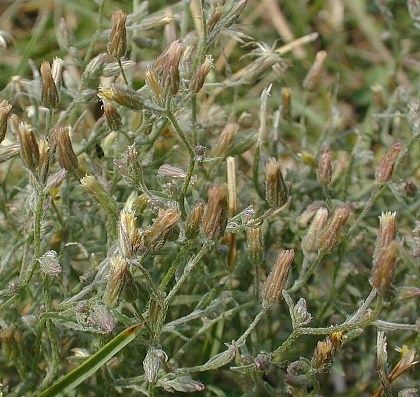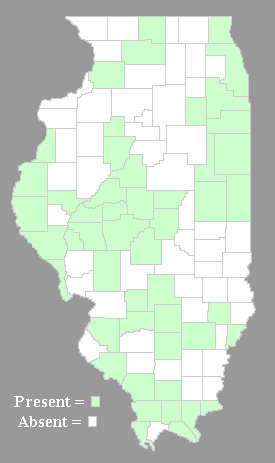Description: This plant is a spring or summer annual that becomes 4-8" tall. It branches frequently and has a bushy appearance. The slender stems are greyish green from short appressed hairs. The alternate leaves are up to 1" long and less than 1/8" (3 mm.) across, becoming shorter as they ascend the stems. Like the stems, they are greyish green from short appressed hairs. The uppermost leaves are scale-like and insignificant. All of the leaves are linear, smooth along the margins, and sessile.

Each of the
numerous upper stems terminates in a small flowerhead about 1/6" (4
mm.) in length. This flowerhead has several pale yellow disk florets,
while the
surrounding ray florets are purple or absent. When they are present,
the ray florets are quite small and insignificant. The cylindrical base
of the flowerhead is surrounded by 2 or 3 levels of overlapping linear
bracts. These bracts are greyish green, pale purple, or brown. The
outer surface of each bract is often covered with short appressed
hairs. The blooming period occurs from early summer to early fall and
lasts about 1-2 months. There is no noticeable floral scent. Each
floret in the flowerhead develops into a light tan achene with a tuft
of short white hairs. This achene is linear in shape and lacks a
significant beak. As the achenes are released to the wind, the floral
bracts spread outward, exposing a naked receptacle (the inner base of
the flowerhead to which the achenes are/were attached). The root system
consists of a short taproot that branches
frequently. This plant
spreads by reseeding itself and occasionally forms colonies.
taproot that branches
frequently. This plant
spreads by reseeding itself and occasionally forms colonies.
Cultivation:
The preference is full sun, dry conditions, and poor soil containing
clay, gravel, or sand. This plant tolerates occasional mowing because
of its low growth habit. It does not tolerate much competition from
taller grasses and forbs.
Range & Habitat:
The native Dwarf Fleabane occurs occasionally in scattered areas
throughout
Illinois. Habitats include dry upland areas of prairies, glades,
pastures, abandoned fields, areas along railroads and roadsides, vacant
lots with sterile soil, lawns, and miscellaneous waste areas. Dry
disturbed areas with scant vegetation are preferred.
Faunal Associations:
Little information is available about floral-faunal relationships for
this species. The nectar and pollen of the flowerheads probably attract
various flies, wasps, and small bees (primarily Halictid bees); these
are the insects that usually visit the flowerheads of Conyza
canadensis (Horseweed), which have a similar structure and
appearance. The bitter-tasting foliage is not attractive to mammalian
herbivores.
Photographic Location:
A mowed lawn near a grocery store in Urbana, Illinois. This lawn was
not far from a railroad.
Comments:
Dwarf Fleabane is a rather non-descript little weed that has
uninteresting flowers. It stands out from other vegetation by the
greyish appearance of its finely branched foliage. The small
flowerheads of this species resemble those of Conzya
canadensis (Horseweed), except the tiny ray florets of the
latter species are white. Horseweed is usually tall (up to 6') and
little branched, although dwarf specimens of this species can occur in
dry areas with sterile soil. Even a dwarf specimen of Horseweed can be
distinguished from Dwarf Fleabane by its greener foliage and the
presence of a central stem with spreading white hairs. Dwarf Fleabane
has only short appressed hairs and it lacks a central stem.